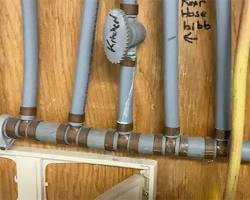
If your house was built between the late 1970s and mid-1990s, you might have what’s known as Quest plumbing lines. These are gray, flexible pipes made of a material called polybutylene (PB). While they were hailed as a revolutionary plumbing solution at the time, they can become brittle and prone to leaks over the decades.
Here’s what you need to know about Quest water lines and why repairs aren’t a viable option:
Quest is simply a brand name for polybutylene pipes. They were popular because they were:
There are a number of reasons why Quest piping might eventually fail. The industry behind Quest piping has claimed that there were no inherent problems in the pipes and tubing, but instead issues with the way they were originally installed, specifically with pipe connectors. However, it’s been suggested that the failures in Quest piping in the USA are most likely linked to differences in municipal chemical water supplies. This has led to Quest and any form of polybutylene no longer being approved as forms of plumbing material in building codes across the US.
Unfortunately, over time, polybutylene pipes can deteriorate due to:
While a leaky Quest pipe might seem like a simple plumbing fix, here’s why repairs are generally not recommended:
Lawsuits were filed against Quest throughout the 1980s and well into the 1990s, alleging defective manufacturing and installation, resulting in damages amounting to hundreds of millions of dollars. Quest has never actually admitted to knowing that this plumbing was defective. But they nonetheless did agree to fund a class-action settlement.
The safest course of action is to repipe your entire plumbing system with a modern material like copper or PEX (cross-linked polyethylene). While repiping is a significant investment, it can prevent future leaks and potential water damage. If you’re experiencing issues with leaks or have difficulty renewing your homeowner’s insurance due to Quest pipes, you might want to consider replacing your Quest piping.
Here are some signs that may indicate you have Quest pipes and need to consider repiping:
Conclusion
Quest water lines were once a common plumbing solution, but age and material limitations make them a potential plumbing hazard. If you suspect you have Quest pipes in your home, give our Auger Pros team a call to discuss repiping options and enjoy the peace of mind that comes with a safe and reliable water delivery system.